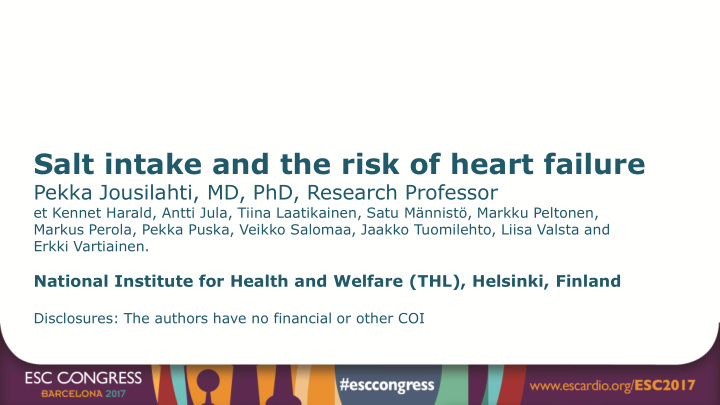



Salt intake and the risk of heart failure Pekka Jousilahti, MD, PhD, Research Professor et Kennet Harald, Antti Jula, Tiina Laatikainen, Satu Männistö, Markku Peltonen, Markus Perola, Pekka Puska, Veikko Salomaa, Jaakko Tuomilehto, Liisa Valsta and Erkki Vartiainen. National Institute for Health and Welfare (THL), Helsinki, Finland Disclosures: The authors have no financial or other COI
Background • High salt (sodium chloride/NaCl) intake is one of the major causes of high blood pressure and an independent risk factor for coronary heart disease (CHD) and stroke • In addition to CHD and stroke, hearth failure (HF) is one of the major cardiovascular diseases in Europe and globally • To the date the role of high salt intake in the development of HF has not been established
Background (cont.) • High salt intake is one of the major lifestyle-related risk factors for CVD • WHO recommendation for salt intake is a maximum of 5 grams per day • Salt is essential for human body but the biological need is only 2-3 grams per day • In most populations salt intake is higher than the biological need or WHO recommendation • Estimation of individual salt intake is methodologically challenging – Suitable population-based cohorts are rare – Sodium extraction is considered as the gold standard for salt intake estimation at individual level. At least 24-hour urine should be collected.
Purpose and key points about methods • To estimate the relationship of salt intake and the risk of HF • A large population-based cohort of 4630 men and women aged 25-64 at baseline who participated in the North Karelia Salt Study or the National FINRISK Study between 1979-2002 • Baseline measurements: questionnaire on health behavior, clinical measurements, blood samples, and collection of 24-hour urine sample • One gram salt intake was calculated as equal of 17.1. mmol sodium excretion • Twelve-year follow up of an incident HF diagnosis through national health records: Causes of death, hospital discharge and drug reimbursements • During the follow-up 121 men and women developed new HF • Cox proportional hazard models were used to estimate the risk of HF at different levels (quintiles) of salt intake
Results: Hazard ratio of a new HF diagnosis at different levels of salt intake Salt intake (quintiles) Adjusted for age and sex +SBP, BMI and S-chol 1st (below 6.77 g/day) 1.0 (reference) 1.0 (reference) 2nd (6.77-8.80g/day) 0.83 1.13 3th (8.81-10.95g/day) 1.40 1.45 4th (10.96-13.73g/day) 1.70 1.56 5th (over 13.73g/day 2.10 1.75 P for the trend 0.002 0.009
Conclusions • High salt intake increases the risk of HF markedly • Salt related increase of HF risk is independent of blood pressure, BMI and serum cholesterol level • Subjects consuming over 13.7 grams salt daily had two times higher risk of HF, compared to those consuming less than 6.8 grams – Due to methodological reasons, these risks observed may be underestimates, e.g. regression dilution bias due to a single baseline measurement • Optimal salt intake is most probably even lower • For more detailed risk estimation, larger pooled population cohorts are needed
Recommend
More recommend